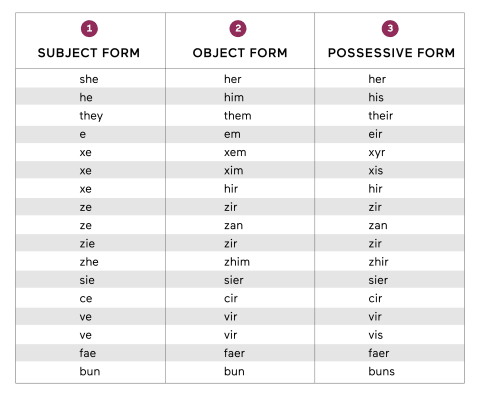Advertisement
A Guide To Neopronouns, From Experts & People Who Use Them



Language is constantly changing. Right now, it's doing so at a rapid pace to accommodate gender identity and expression (it's about time!). An excellent example of this can be found in the exploration of neopronouns. And no, this has nothing to do with The Matrix.
What are neopronouns?
Before we explain neopronouns, let's talk about pronouns in general, specifically as they relate to gender. Pronouns are a part of a person's gender. They are the terms that individuals use to refer to themselves and to reflect their gender. Common gender pronouns include she/her, he/him, and they/them, and then there are also neopronouns, such as ze/zir or fae/faer.
According to Dainis Graveris, a sex educator and founder of Sexual Alpha, neopronouns are a category of new pronouns that intentionally go beyond the traditional gender binary of masculine and feminine. While some people consider they/them/theirs pronouns as the go-to gender-neutral pronouns, they still limit individuals to three pronoun categories—he, she, or they. That's where neopronouns come in.
"Neopronouns empower folks who feel different from the rest of the world to be true to themselves when all other pronouns and labels don't fit them," Graveris explains to mbg. "For some people, these pronouns recognize both their masculine and feminine sides. For others, they help them express their unique gender identity to others."
That said, using neopronouns is still relatively uncommon in the United States. A 2020 Trevor Project study of 40,000 young members of the LGBTQ+ community found that while a full quarter of them use nonbinary pronouns of some sort, just 4% specifically used neopronouns.
Neopronoun examples.
There is a large variety of neopronouns, which include, but are not limited to, the following:
- e/em/eirs
- hie/hym/hiz
- ne/nem/nears
- tey/tem/ters
- xe/xem/xers
- ze/hir/hirs
To take it a step further, noun-self pronouns also fall under the neopronoun umbrella.
"These pronouns contain preexisting words that are used as pronouns. They are a unique way of exploring one's understanding of their own gender," Graveris explains. "For example, they can refer to fantasy/animé characters like fae/faer/faeself and vamp/vampself; animals like bee/beeself, kitty/kittyself, and bun/bunself; or other objects like star/starself and moon/moonself. Some people even use emoji-self pronouns."
How to use neopronouns in a sentence.
First things first: "Please remember, someone's gender is more important than 'proper grammar,' so let that go," says licensed therapist Rachel Wright, LMFT.
Using neopronouns in full sentences is as simple as replacing the typical pronouns (he, she, him, her, etc.) with the neopronoun of the person you're speaking about.
To help, Heather Bonikowski, a lexicographer at Dictionary.com, suggests using the chart below. It shows traditional pronouns and some (not all) nonbinary pronouns, along with the grammatical function of each one to show how they're used.

You can plug each set into this sentence to see how each pronoun is used:
- [Column 1, subject form] told me to text [column 2, object form], but I don't have [column 3, possessive form] number.
Here are some examples of both traditional pronouns and neopronouns in use:
- She told me to text her, but I don't have her number.
- They told me to text them, but I don't have their number.
- Xe told me to text xem, but I don't have xyr number.
- Ve told me to text vir, but I don't have vis number.
Why people use neopronouns.
People use neopronouns for many different reasons. Jesse Kahn, LCSW-R, CST, certified sex therapist and director at the Gender & Sexuality Therapy Center, says one of those reasons is cultural.
"Many pronouns have a lot of cultural assumptions attached to them, but since neopronouns have no inherent link to gender, they can disrupt assumptions someone is making about someone's gender," they explain.
This sentiment is echoed by the musician Dua Saleh, who uses the pronouns xe/xyr/xim, in a series of tweets shared on Twitter. "More recent neopronouns (new pronouns) have context within online subgroups created by trans/queer youth, creating shifts in ways [people] subvert Western heteropatriarchy and binaries," xe tweeted. "It's also really affirming to find the pronouns that are right for you even if they're private to you. This is a privilege for me [because] often universally used languages are rooted in the binary."
Other neopronoun users say the decision to use them is rooted in fun and personalization.
"Neopronouns are fun!" one user wrote in a recent Reddit thread. "They often fit better with how I feel, and they're what you make of them! Are [they] masculine? Are they feminine? Are they gender neutral? I don't care! It's up to me."
Origins and history.
The term "neopronoun" might sound foreign or like something that was just introduced, but neopronouns have actually been around since the mid-1800s, according to Bonikowski. For example, the neopronoun "thon" was a big one back in the day: "Thon"—short for "that one"—was introduced in 1858 and served as a singular, gender-neutral pronoun. It was even added to the Merriam-Webster Dictionary in 1934 but removed in 1961.
While most of those neopronouns fell out of use or have not been in continuous use—like "hesher" and "ze"—Bonikowski notes that people have been trying to tinker with pronouns to reflect gender neutrality for centuries. "From the mid-1600s, English language style guides also promoted the use of 'generic he' to include any single person in the third person of any gender," she explains. "During the 1970s and '80s, perhaps related to second-wave feminism, 'generic she' was used by some writers. Some people alternated between using 'she' and using 'he,' or consistently wrote out the longer phrase 'he or she.' Novel forms like 's/he' were used in the 1990s and early 2000s."
Throughout history, neopronouns were even coined and pushed by state legislatures to clarify that laws should apply to any individual (whereas "generic he" can be read as applying only to men), she continues. Some newspapers and universities have also promoted the use of neopronouns: As described in linguist Dennis Baron's book What's Your Pronoun?: Beyond He and She, the Sacramento Bee used "hir" for almost 30 years starting in the 1920s, and Mississippi even entertained a bill proposed in 1922 to adopt the pronouns "hesh/hiser/himer" that failed by only one vote.
More recently, the singular "they" has enjoyed a broader acceptance, even in edited, published writing. It's used by many nonbinary people, though it does still have other uses for an unspecified singular referent. Neopronouns, however, are now primarily used by nonbinary people. And things have significantly improved when it comes to neopronoun inclusion, too: The Oxford English Dictionary added the neopronouns "ze" and "thon" in 2018 and "hir" and "zir" in 2019. In 2021, AI writing assistant Grammarly added support for neopronouns including xe/xem, ze/zir, ve/ver, and ney/nem. And social media sites like Facebook and Instagram allow users to pick from over 50 gender identities. Still, we have ways to go.
Criticisms.
Neopronouns and folks who use them have attracted quite a bit of criticism. According to sexologist Carol Queen, Ph.D., pronouns in general have become a culture war issue of sorts. "I think there are people who make a big drama about this because they do believe in the binary," she explains. "But I also think some are ungracious about it because they just find it hard to accept change and remember new information. They're worried they'll screw up and so are not very graceful about it overall."
According to Ley Cray, Ph.D., director of LGBTQIA+ Programming at virtual mental health clinic Charlie Health, the use of neopronouns in particular—especially noun-self pronouns—is a point of some debate even within TGNC (transgender and gender nonconforming) communities.
"Some criticize the practice of using neopronouns on the grounds that, linguistically, they're simply too challenging to use, making them unlikely to be taken up as a general part of the language," Cray explains. "Others refer to some sort of mythical 'purity' of language and grammar—though these criticisms tend to rely on a misunderstanding of the historical development of language and also on the nature and role of grammar itself."
When it comes to TGNC communities, some defend the use of neopronouns and noun-self pronouns on the grounds that they expand the range of options for gender-nonconforming persons to relate to and express their gender. Others see the use of such pronouns as a sort of activism meant to reveal the absurdity of gendered language, to begin with.
"At the same time, some within TGNC communities resist the widespread use of neopronouns and especially noun-self pronouns, with the idea being that such pronouns make it harder for the broader TGNC community to thrive," Cray explains. "Such critics will suggest that neopronouns and non-self pronouns make it harder for TGNC persons who use more conventional pronouns to stand up against their own misgendering and also lead to an overemphasis on pronouns in the fight for TGNC rights, at the expense of focus on protecting accessible health care, protections in housing and employment, etc."
Why pronouns matter—for everyone.
Pronouns aren't everything, but they are linked to our identities, expression, and help shape how we see ourselves and how we're seen and perceived by others. More often than not, this is related to gender identity, and as Queen explains, gender is a primary "sorting mechanism" for many people and often connected to one's sense of sexual orientation. That means pronouns can be not only central to the way we think about and refer to people (ourselves and others) but also fraught if we don't feel like our pronouns match our sense of ourselves.
"This is largely where neopronouns come from—they are a way to get beyond binary pronouns and hence categories—pronouns are shorthand for those, so I would say it's generally not just the pronoun but also what it represents and whether that representation fits," she adds.
Additionally, Kahn says people make sometimes accurate and sometimes inaccurate assumptions about someone's gender based on their appearance, name, and pronouns.
"What this says, though, is that people have to look, sound, present, and be named in specific ways to be seen as who they are. Using someone's correct pronouns is one of the many ways we can respect someone and demonstrate that we see them as who they are."
How to use neopronouns correctly:
Remember: This is about respect.
Wright points out that people will sometimes feel like they "can't keep up" with new words, but she encourages focusing less on the grammar and more on the respect. "It's not a matter of keeping up; it's a matter of respecting someone's gender," she notes.
Don't assume.
Queen says it's important to disrupt the automatic "this person looks female so must be female; therefore, her pronouns are she/her" situation. If you do nothing else, try to check that assumption!
Ask.
"While it is commonly recommended that we ask people their pronouns, I prefer to ask: 'How should I refer to you?' This more indirect approach avoids putting people who are not public about their pronouns and identity in a situation in which they either must 'out' themselves or lie," Cray says.
Write it down.
Cray suggests a simple trick: "If you find yourself struggling with someone's pronouns, try writing a few sentences about them—sentences that make use of the pronouns in question. Maybe commit to writing three sentences per 'slip-up,' or even include this as part of a more general journaling practice even before 'slip-ups' occur."
Keep it moving.
And if you do slip up with respect to someone's pronouns, the best thing to do is to acknowledge the mistake briefly but sincerely by apologizing, correcting, and moving on, Cray says. For example, "He said…I'm sorry, ze said…"
Extended apologies or exaggerated corrections can be very uncomfortable for the person you're referring to and can often put them in the position of having to expend emotional energy on consoling someone who just misgendered them.
Queen adds that if we make a mistake and gracefully own it, it feels very different from being dramatic about how hard it is to remember someone's pronouns. Don't do the latter—it's not about you.
The takeaway.
When it comes to neopronouns (and pronouns in general), things have progressed, but there is still work to be done. People who use pronouns outside the gender binary, like neopronouns, deserve to be able to do so in all aspects of life, from social media accounts to official government forms. However, until we get there, it's important to show your support however you can. If you are someone who uses neopronouns, know that your personal experiences are valid; your gender identity and expression are valid.
Watch Next
Enjoy some of our favorite clips from classes
Enjoy some of our favorite clips from classes
What Is Meditation?
Mindfulness/Spirituality | Light Watkins
Box Breathing
Mindfulness/Spirituality | Gwen Dittmar
What Breathwork Can Address
Mindfulness/Spirituality | Gwen Dittmar
The 8 Limbs of Yoga - What is Asana?
Yoga | Caley Alyssa
Two Standing Postures to Open Up Tight Hips
Yoga | Caley Alyssa
How Plants Can Optimize Athletic Performance
Nutrition | Rich Roll
What to Eat Before a Workout
Nutrition | Rich Roll
How Ayurveda Helps Us Navigate Modern Life
Nutrition | Sahara Rose
Messages About Love & Relationships
Love & Relationships | Esther Perel
Love Languages
Love & Relationships | Esther Perel











